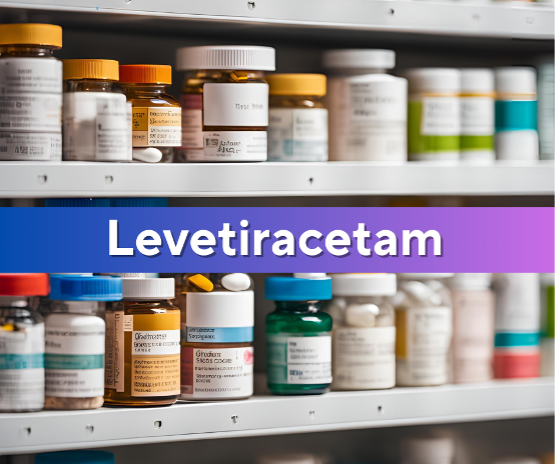Za Pharmacy
Drugs, Supplies and Delivery
Levetiracetam
Levetiracetam is a widely used anticonvulsant medication primarily prescribed for the treatment of epilepsy. It is effective in managing various types of seizures, including focal (partial) seizures, generalized seizures, and myoclonic seizures. Levetiracetam is known for its unique mechanism of action, favorable side effect profile, and broad spectrum of activity. This article provides a detailed overview of levetiracetam, including its mechanism of action, uses, dosage, side effects, precautions, drug interactions, and generic names, referencing authoritative sources such as the British National Formulary (BNF), Lippincott Textbook of Pharmacology, and Lange Basic & Clinical Pharmacology.
Levetiracetam exerts its therapeutic effects through a unique mechanism that differentiates it from other anticonvulsants. Its key mechanisms include:
- Binding to Synaptic Vesicle Protein 2A (SV2A):
- Levetiracetam binds to the SV2A protein, which is involved in the regulation of neurotransmitter release.
- This binding modulates synaptic vesicle exocytosis, reducing the release of excitatory neurotransmitters and stabilizing neuronal activity.
- Inhibition of N-Type Calcium Channels:
- Levetiracetam inhibits N-type calcium channels, which play a role in neurotransmitter release and neuronal excitability.
- Modulation of GABA and Glycine Receptors:
- Levetiracetam enhances the inhibitory effects of GABA and glycine, further contributing to its anticonvulsant properties.
- Reduction of Neuronal Hyperexcitability:
- By modulating synaptic vesicle function and calcium channels, levetiracetam reduces neuronal hyperexcitability, which is crucial in controlling seizures.
Levetiracetam is approved for a variety of clinical conditions, including:
- Epilepsy:
- Adjunctive therapy for focal (partial) seizures with or without secondary generalization in adults and children aged 1 month and older.
- Monotherapy for focal seizures in adults and adolescents aged 16 years and older.
- Adjunctive therapy for generalized tonic-clonic seizures in adults and children aged 6 years and older.
- Adjunctive therapy for myoclonic seizures in adults and adolescents aged 12 years and older with juvenile myoclonic epilepsy.
- Off-Label Uses:
- Neonatal seizures.
- Status epilepticus (as an adjunctive therapy).
- Migraine prophylaxis.
The dosage of levetiracetam varies depending on the indication, patient age, and clinical response. The following dosing guidelines are based on the British National Formulary (BNF) and clinical pharmacology references:
- Adults and Adolescents (16 years and older):
- Adjunctive Therapy: Start with 500 mg twice daily, increasing by 500 mg every 2–4 weeks to a maintenance dose of 1000–3000 mg daily in divided doses.
- Monotherapy: Start with 250 mg twice daily, increasing by 250 mg every 2 weeks to a maintenance dose of 1000–3000 mg daily in divided doses.
- Children (6–15 years):
- Adjunctive Therapy: Start with 10 mg/kg twice daily, increasing by 10 mg/kg every 2 weeks to a maintenance dose of 30–60 mg/kg daily in divided doses.
- Infants (1 month to 5 years):
- Adjunctive Therapy: Start with 10 mg/kg twice daily, increasing by 10 mg/kg every 2 weeks to a maintenance dose of 25–50 mg/kg daily in divided doses.
Important Considerations:
- Levetiracetam is available in oral tablets, oral solution, and intravenous (IV) formulations.
- Dose adjustments may be necessary for patients with renal impairment.
- Therapeutic drug monitoring is not routinely required but may be useful in certain cases.
Levetiracetam is generally well-tolerated, but it is associated with a range of side effects, some of which can be serious. Common side effects include:
- Central Nervous System:
- Drowsiness, dizziness, and headache.
- Behavioral changes, including irritability, aggression, and mood swings.
- Gastrointestinal:
- Nausea, vomiting, and diarrhea.
- Other:
- Fatigue, weakness, and nasopharyngitis.
Serious Side Effects:
- Psychiatric Symptoms: Depression, suicidal thoughts, and psychosis (rare).
- Hematological: Leukopenia and thrombocytopenia (rare).
- Allergic Reactions: Rash, angioedema, and anaphylaxis (rare).
Levetiracetam requires careful monitoring and adherence to specific precautions to ensure patient safety:
- Psychiatric Symptoms:
- Monitor for behavioral changes, depression, and suicidal thoughts, particularly in patients with a history of psychiatric disorders.
- Pregnancy and Lactation:
- Levetiracetam should be used during pregnancy only if the potential benefits outweigh the risks. It is excreted in breast milk, so breastfeeding is generally not recommended.
- Renal Impairment:
- Dose adjustments are necessary for patients with impaired kidney function. The dose should be reduced in patients with a creatinine clearance (CrCl) of less than 80 mL/min.
- Elderly Patients:
- Lower doses may be required due to increased sensitivity to side effects, particularly dizziness and sedation.
- Withdrawal:
- Levetiracetam should be tapered gradually to avoid withdrawal symptoms, including increased seizure frequency.
Levetiracetam has a low potential for drug interactions due to its lack of metabolism via cytochrome P450 enzymes. However, key interactions include:
- Central Nervous System Depressants:
- Alcohol, benzodiazepines, and opioids can enhance sedation and respiratory depression.
- Other Anticonvulsants:
- Levetiracetam may enhance the sedative effects of other anticonvulsants.
- Other Interactions:
- Methotrexate: Levetiracetam may increase the risk of methotrexate toxicity.
Levetiracetam is the generic name for this medication. It is marketed under various brand names, depending on the country and manufacturer. Some examples include:
- Keppra (a well-known brand in the United States and other regions).
- Levetiracetam Accord.
- Levetiracetam Mylan.
- Levetam.

